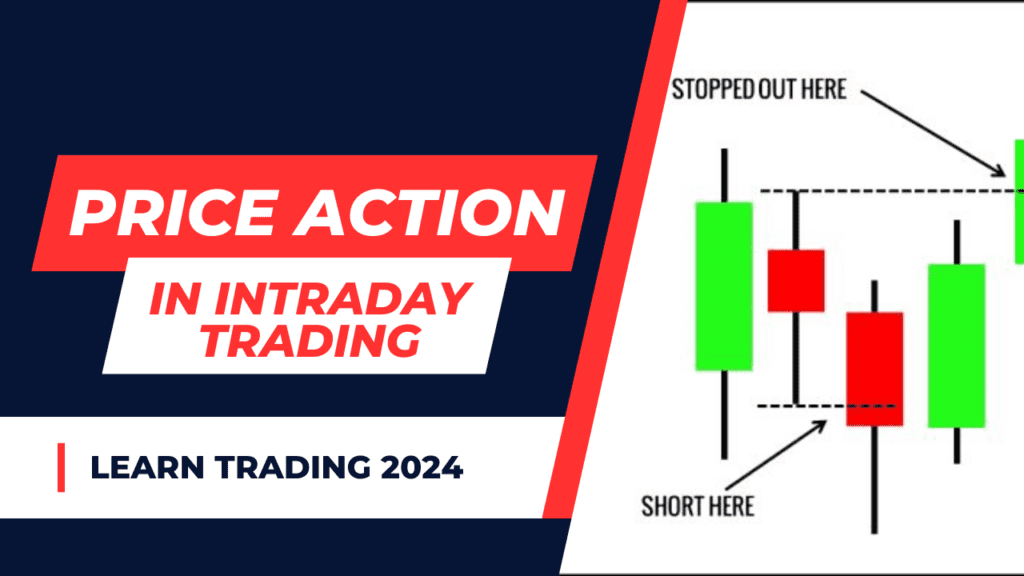Price Action in Intraday Trading plays a crucial role in intraday trading, allowing traders to make decisions based on the movement of stock prices. In this article, we’ll explore how you can utilize price action to enhance your intraday trading strategy.
What is Price Action in Intraday Trading?
Price action refers to the changes in demand and supply over time that influence the price of a stock. When traders use price action to guide their decisions in intraday trading, it’s simply called price action trading.
Understanding Price Action in Intraday Trading
Price action isn’t overly technical; in fact, it’s quite straightforward. By analyzing stock charts, traders can identify patterns and trends that help predict future price movements. Some common chart patterns in price action trading include the bullish rectangle, double top, double bottom, and head-and-shoulders patterns, all of which help traders determine market direction.
Key Topics Covered:
- How to Identify Price Action in Intraday Trading
- What Price Action Means in the Share Market
- How to Use Price Action for Trading
- Is Price Action Effective for Day Trading?
- Does Price Action Trading Work?
- Benefits of Using Price Action in Trading
- Price Action Movement Analysis
- How to Identify Price Action in Intraday Trading
Price action can be identified by analyzing stock market charts. Look for patterns such as the bullish rectangle, double top, double bottom, and head-and-shoulders. These patterns often indicate future price movements, helping you protect your investments and trade more effectively.
Read Also: ITC Share Price Target: Stock Broker Increases Target to ₹595!
What Does Price Action Mean?
Price action refers to the movement of a stock’s price based purely on market action, without relying on external data or fundamental analysis. It focuses on chart patterns, such as support and resistance levels, candlestick formations, trend lines, and other visual indicators within the chart.
For example, patterns like the head-and-shoulders or shooting star provide insights into potential market direction, helping traders predict whether prices will rise or fall.
Price Action in the Stock Market
Price action is not overly technical; it’s simple and intuitive. By reading stock charts and identifying patterns such as support, resistance, tops, bottoms, and candlestick formations, traders can make decisions based on real-time price behavior.
Key Components of Price Action
Price action includes several key elements that traders use:
- Indicators like Fibonacci retracement
- Trend lines and chart patterns
- Candlestick formations
- Momentum
- Support and resistance levels
- Historical price data
By analyzing historical charts, traders can predict future trends, and with the help of various indicators, make informed investment and trading decisions.
How to Use Price Action
Using price action is straightforward. Begin by analyzing a chart to identify patterns or trends. By understanding whether the market is trending up or down, and applying tools like indicators or support/resistance levels, you can develop a strategy for making trades based on price action.
This approach allows you to anticipate market movements and invest accordingly.
You can create your own trading strategy using price action, which can guide your stock market investments.
Nowadays, learning price action is easier than ever. You can follow YouTube channels and analyze live markets to develop your own strategy based on real-time data.
Read Also: Defense Stocks on the Rise: A Golden Opportunity for Investors in 2024?
Is Price Action Good for Day Trading?
Absolutely! Price action is effective for all types of trading, including day trading. By analyzing price movements, you can predict a stock’s future direction. Most professional traders rely heavily on price action to guide their decisions.
For successful day trading using price action, keep the following in mind:
- Standard time frames
- Fibonacci retracement
- Market trends
- Psychology and mindset
- Money management
These factors are essential to sustaining long-term success in the market. Ignoring them can limit the effectiveness of price action trading.
Does Price Action Trading Really Work?
Yes, price action works, but it’s crucial to understand the current market behavior and the type of trend you’re dealing with. While there are three types of trends—uptrend, downtrend, and sideways—many traders fail to recognize when the market shifts to another trend.
If you can detect challenging market conditions, you’ll be better positioned to avoid losses by knowing when to trade and when to stay out. Successful trading isn’t based solely on price action but on a combination of factors.
This is why 90% of traders experience losses, while only 10% succeed. The key is knowing which trades to make and when to make them, following a structured approach to every trade.
Benefits of Price Action in Trading
Focus on Current Momentum: Price action allows you to predict whether a stock will rise or fall based on its current momentum.
Instant Feedback: Price action gives real-time insights, telling you when to buy or sell.
Works Across Markets: Whether you’re trading cryptocurrency, stocks, or indices, price action works across all types of charts.
Ride the Chart: Price action is all about interpreting the movement of prices and following the trends they indicate.
Key Elements of Price Action Movement Analysis:
- Chart Patterns
- Technical Analysis
- Candlestick Patterns
- Support and Resistance Levels
- Time Frame Combinations
- Stock Market Indicators
Price Action Trading Books
If you want to deepen your understanding of price action from beginner to advanced levels, consider reading some trending books on the subject. These books cover everything from basic concepts to advanced trading techniques, giving you a comprehensive guide to trading using price action.







